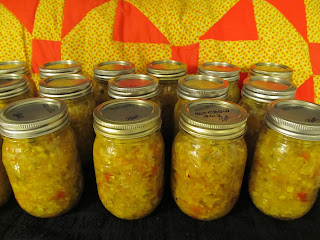 |
| Deb Callahan's Chow Chow |
During our Tuesday Grow Appalachia meeting we welcomed Melinda
Alcorn, Community Educator for the Safe Foods Project to present on the hidden
dangers of packaged food. Melinda guided us through a discussion on BPA (Bisphenol A) usage by food companies.
What is BPA? BPA was originally manufactured as a synthetic estrogen.
It is currently used to harden plastic and as a protective barrier against
metal corrosion and bacteria in canned foods.
What’s the big deal? Studies have found that BPA has leached into
the food in 92% of cans found in the grocery store. BPA is an endocrine disruptor
that affects how hormones carry messages throughout our bodies. Even low levels
of exposure have been linked to breast and prostate cancer, infertility, diabetes,
thyroid disorders, early puberty, and even attention deficits and behavioral
problems. BPA is also an obesegen, which changes precursor cells into fat cells
and changes metabolism rates so we accumulate more calories instead of burning
them.
Where is BPA found? BPA can
be found in many products, such as DVDs, receipts, pop cans, re-usable water bottles,
baby bottles, and Sippy cups. BPA is predominately found in the plastic linings
of cans used to store food. Fortunately, many companies are phasing out BPA use
in re-usable water bottles, baby bottles, and Sippy cups (look for the label
“BPA free”).
What can we do to avoid BPA?
1.
Eat fresh food! This is where Grow Appalachia
shines again! By growing our own food and preserving it ourselves for the
winter we are lowering our exposure drastically.
2.
Purchase dried beans rather than canned and
frozen produce rather than canned.
3.
Pay attention to the type of plastic you are
buying. Check on the bottom of containers for the recycle symbol. Inside the
symbol there should be a number. Plastics numbered 1, 2, 4, and 5 are better.
Avoid #3 (PVC), #6 (polystyrene), and #7 or “PC” (Polycarbonate). #3 and #6 do not contain BPA, but are still more toxic than the other numbers. Click here to learn more about what recycling codes tell us.
4.
Purchase items packaged in glass or aseptic multi-layer boxes.
For more information about BPA read the No Silver Lining Report or
the Kentucky Safe Foods Fact Sheet. For more information about the Kentucky
Safe Foods Project please visit the Toxics Free Future webpage.

No comments:
Post a Comment